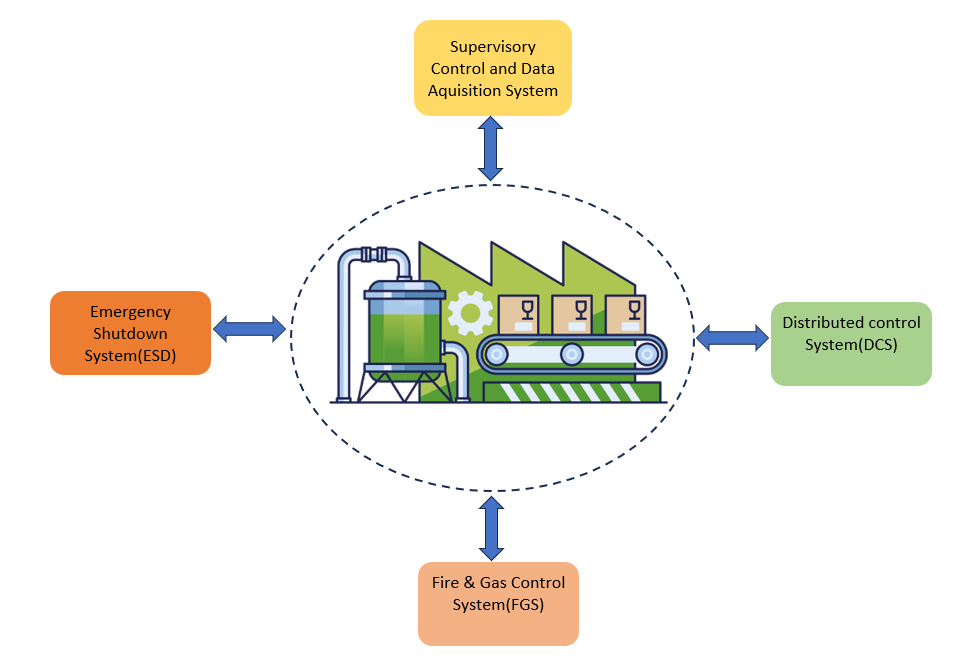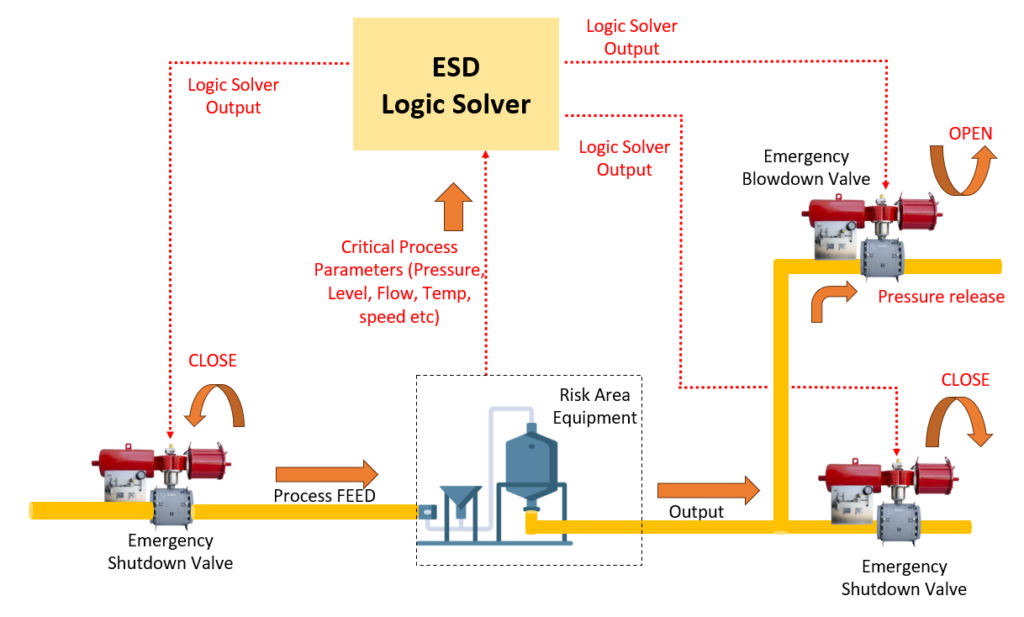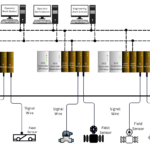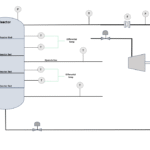Introduction
In high-risk industrial environments such as oil and gas, petrochemical, power plants, and manufacturing, safety is of paramount importance. Any unforeseen failure or hazardous condition can lead to catastrophic consequences, including fires, explosions, equipment damage, and loss of life. To mitigate these risks, industries implement an Emergency Shutdown System (ESD) as a critical safeguard.
Usually In Any Process Plant Facility, there are Critical Equipment that function while processing some kind of Feed and producing some valuable product. Any Process Facility Control System has mainly a combination of three types of Control Systems; DCS, ESD and FGS. Any other Third party supplied system such as Compressor control System, Analyzer management system, Machine Monitoring System etc. will interface with these three systems, in addition, SCADA systems are often deployed to monitor the Process plant from a remote Centralized facility.

Though the above Infographic shows all four types on Control system types that are usually deployed for a Process Facility, we will limit our discussion to only Emergency Shutdown systems.
This article provides an in-depth analysis of what an Emergency Shutdown System is, how it works, its components, types, design considerations, industry standards, and its significance in industrial safety.
An ESD system mainly consists of ESD PLC which is always Redundant/Tri-Modular Redundant. This Safety PLC (also called ESD Logic Solver) mainly accepts inputs from sensors, executes a pre-defined Logic and produces change of state in terms of output. The name Emergency Shutdown System derives from the nature of its functioning i.e. Isolating a Risk Area Equipment or an entire Facility when some pre-defined conditions occur.
An Emergency Shutdown System (ESD) is a dedicated safety instrumented system (SIS) that detects hazardous conditions and automatically initiates protective actions to minimize the risk of accidents. It is an integral part of industrial safety protocols, ensuring that a plant or equipment is safely shut down when normal process control mechanisms fail.
The primary objectives of an ESD system are:
- Preventing loss of containment (e.g., stopping toxic or flammable substances from leaking)
- Isolating energy sources (e.g., shutting off fuel supplies, cutting power)
- Stopping hazardous processes before they escalate
- Reducing pressure and temperature to avoid explosions
- Mitigating fire and toxic gas exposure risks
A Pictorial Representation of an ESD system is shown below wherein Critical Parameters from a Risk Area Equipment are monitored and then based on a logic in the Logic solver PLC, inlet and outlet Pipes are Closed by Emergency Shutdown Valves. Also, the System Pressure is released by opening another Valve called Emergency Blowdown Valve.

An ESD is designed to rapidly bring a facility or process to a safe condition when predefined hazardous conditions are detected.
ESD Systems are completely segregated in terms of Hardware and Software Implementation. The Field Sensors, PLC, Control Panels in Remote Equipment rooms, Engineering Workstations, and Database all are completely independent from rest of the Plant control System such as DCS or SCADA.
In essence, an ESD system acts as a last line of defense, preventing catastrophic failures by taking rapid, automated action.
Key Components of an ESD System
An Emergency Shutdown System consists of multiple hardware and software components working together to detect hazards and take corrective actions.
1. Sensors & Field Devices
These devices monitor critical process variables and provide real-time data to the ESD system. Examples include:
- Pressure Transmitters – Detect overpressure conditions
- Gas Detectors – Identify leaks of flammable or toxic gases
- Temperature Sensors – Prevent overheating conditions
- Level Sensors – Monitor liquid levels in tanks and pipelines
- Fire & Smoke Detectors – Identify potential fire hazards
The Availability of Sensors and field Devices such as Transmitters are crucial to mitigate risk. IEC 61511(Process Industry standard for Functional Safety) specifies Various SIL Levels for such Devices.
2. ESD Logic Solver (Controller / PLC / SIS)
The logic solver acts as the brain of the ESD system. It receives signals from sensors, evaluates conditions, and triggers shutdown actions. Common types include:
- Programmable Logic Controllers (PLC) – Used for automation and quick response
- Safety Instrumented Systems (SIS) – High-reliability controllers that comply with SIL (Safety Integrity Level) standards
3. Final Control Elements (Shutdown Devices)
Once a shutdown is triggered, the system activates these safety mechanisms:
- Emergency Shutdown Valves (ESV) – Cut off fluid or gas flow in pipelines
- Depressurization Systems – Release excess pressure to prevent explosions
- Motorized Actuators – Shut down pumps, compressors, and turbines
- Electrical Isolation Devices – Trip circuit breakers to cut power
4. Human-Machine Interface (HMI) & Alarm System
Operators interact with the ESD system through HMI displays, receiving:
- Real-time alerts and notifications
- Visual indicators of shutdown status
- Manual override options (if required)
Working Principle of an Emergency Shutdown System
Step 1: Hazard Detection
Sensors continuously monitor pressure, temperature, gas levels, and other critical parameters. When a value exceeds the preset threshold, a signal is sent to the logic solver.
Step 2: Decision-Making & Processing
The logic solver (SIS or PLC) evaluates the signal. If the condition meets the shutdown criteria, it triggers a response to initiate corrective actions.
Step 3: Activation of Shutdown Devices
The final control elements execute emergency actions, such as:
- Closing valves to isolate hazardous areas
- Depressurizing tanks and pipelines
- Stopping motors, pumps, or power supply
Step 4: Alarm Notification & Operator Response
Alarms are activated to alert operators about the shutdown event.
Step 5: System Reset & Restart
Once the hazard is mitigated, the system must be manually reset before resuming operations.
Types of Emergency Shutdown Systems
- Manual Shutdown Systems – Triggered by operators via emergency push buttons or pull stations.
- Automated Shutdown Systems – Triggered automatically when safety limits are exceeded.
- Hybrid Systems – Combine manual and automatic triggers for enhanced safety.
Design Considerations for ESD Systems
- SIL (Safety Integrity Level) Compliance – Ensuring reliability as per IEC 61508/IEC 61511
- Redundancy & Fault Tolerance – Using multiple sensors and controllers to prevent failures
- Response Time Optimization – Fast reaction to minimize risk escalation
- Regular Maintenance & Testing – Periodic proof testing to verify system functionality
- Integration with Fire & Gas Systems – Coordinated safety response to multiple hazards
Applications of ESD Systems in Industries
Oil & Gas Industry
- Offshore drilling platforms – Prevent blowouts and gas leaks
- Refineries – Isolate fuel supply during emergencies
Power Plants
- Thermal & Nuclear Plants – Prevent turbine failures and reactor malfunctions
Chemical & Petrochemical Plants
- Prevent hazardous chemical reactions and tank ruptures
Manufacturing & Heavy Industries
- Shut down machinery to prevent overheating or mechanical failure
Failsafe Circuits in Emergency Shutdown (ESD) Systems
Failsafe circuits are designed to ensure that in the event of a failure (e.g., power loss, sensor malfunction, or signal corruption), the system defaults to a safe state rather than remaining in an unsafe operating condition. In an Emergency Shutdown (ESD) System, failsafe circuits play a crucial role in achieving Safety Integrity Level (SIL) compliance by minimizing the risk of dangerous failures.
Key Design Principles of Failsafe Circuits
1. De-Energize to Trip (DTT) Principle
- Most ESD systems are designed such that a loss of power or failure in the control signal automatically triggers a shutdown.
- Example: In a fail-safe valve system, the solenoid valve is held open by an energized coil. If the power is lost, the valve closes automatically due to spring force.
2. Redundancy and Voting Logic (1oo2, 2oo3, etc.)
- 1oo2 (One out of Two): A single sensor failure triggers a trip, ensuring safety but reducing availability.
- 2oo3 (Two out of Three): Majority voting ensures availability while maintaining fail-safe operation.
- Example: Pressure transmitters in a high-pressure pipeline using 2oo3 logic to prevent false trips while maintaining safety.
3. Watchdog Timers & Self-Diagnostics
- Microcontroller-based failsafe circuits use a watchdog timer (WDT) to monitor software and reset the system if it hangs or malfunctions.
- Example: A PLC in an ESD system periodically checks for response from critical sensors. If a failure is detected, it forces the system into a safe state.
4. Normally Closed (NC) vs. Normally Open (NO) Circuits
- Failsafe relays are typically Normally Closed (NC), meaning they open in case of failure (power loss or signal failure), ensuring a safe shutdown.
- Example: Fire detection relay circuits use NC contacts so that any power failure triggers the fire suppression system.
5. Diverse Redundancy for Common-Cause Failure Prevention
- Use multiple types of sensors (e.g., pressure + temperature instead of just pressure) to detect the same failure event.
- Example: A high-temperature furnace system using both thermocouples and IR sensors to detect overheating before an ESD action.
Failsafe Circuit Examples
1. Failsafe Relay Circuit for ESD Valve Control
- Uses Normally Energized (NE) relay coils.
- If power is lost or a fault is detected, the relay de-energizes, triggering the valve to close.
- If power fails: Relay de-energizes → Solenoid valve closes → System enters safe state.
2. Watchdog Timer Failsafe in PLC-Based ESD System
- Microcontroller (PLC) continuously checks system health using a watchdog timer.
- If an error occurs, the watchdog triggers a reset or forces a shutdown.
- If PLC fails to respond: Watchdog activates → Emergency relay opens → System shuts down safely.
3. Failsafe Two-Channel Emergency Stop (E-Stop) Circuit
- Uses two independent NC contacts to ensure safety in case of contact failure.
- If one channel fails, the second still ensures shutdown.
- If either switch is pressed: Circuit opens → Power cuts → Equipment stops safely.
Best Practices for Implementing Failsafe Circuits
✅ Use De-Energize to Trip (DTT) Design: Ensures that failure modes automatically force a safe state.
✅ Implement Dual-Channel & Redundant Paths: Increases reliability by preventing single-point failures.
✅ Incorporate Self-Diagnostics & Periodic Testing: Prevents hidden failures in safety-critical systems.
✅ Use SIL-Certified Components: Ensures compliance with IEC 61508/61511 safety standards.
✅ Employ Diverse Redundancy to Avoid Common-Cause Failures: Uses different sensor types to detect the same parameter.
Importance of an Emergency Shutdown System
1. Ensuring Worker Safety
In hazardous environments, an ESD system protects workers from life-threatening accidents such as explosions, fires, or toxic gas leaks.
2. Equipment Protection
Critical industrial equipment is often expensive and complex. An effective ESD system prevents irreversible damage, reducing repair and replacement costs.
3. Environmental Protection
Industrial accidents can result in chemical spills, toxic emissions, and pollution. ESD systems help in preventing environmental disasters.
4. Regulatory Compliance
Industries must comply with stringent safety regulations set by authorities such as:
- IEC 61508 & IEC 61511 (International standards for safety instrumented systems)
- OSHA (Occupational Safety and Health Administration)
- API RP 556 (American Petroleum Institute for process safety)
Non-compliance can lead to legal actions, heavy fines, and shutdowns.
5. Preventing Financial Losses
Plant shutdowns and equipment failures can result in millions of dollars in lost production. ESD systems minimize downtime and reduce economic losses.
An Emergency Shutdown System (ESD) is a vital safety mechanism in industrial settings, preventing hazardous events, minimizing risks, and ensuring regulatory compliance. As industries advance, modern AI-powered and IoT-based ESD systems are improving response times, predictive maintenance, and overall system reliability.
A well-designed ESD system can mean the difference between a controlled incident and a major disaster. Investing in robust safety solutions is essential for protecting people, assets, and the environment.


